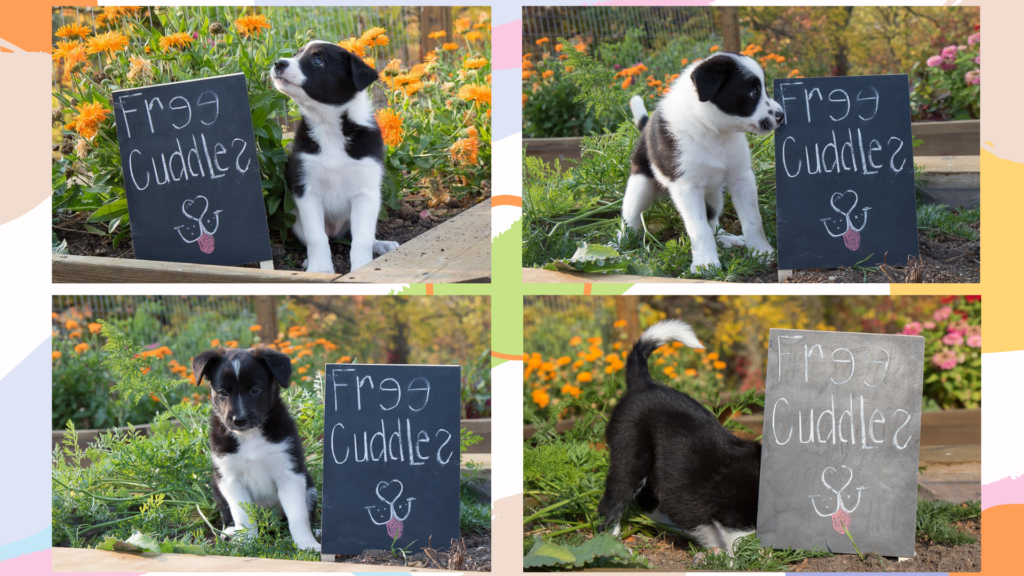One of the common questions about dog training I am asked is how to teach a dog to stand on cue. Now, there are a couple of different types of stands we can train our dog to do. One is a pop up that is a dynamic stand with the dog popping up with his front feet. The other is a kickback stand with no front feet movement. You can train both as I do, but to get started the easiest stand to train for anyone is the pop up.
Training a pop up stand is fun, and it’s just a combination of 3 games. Years ago I did a video tutorial on training the stand with Swagger when he was a puppy, which I’ve got below for you. I included a stand as part of my recent podcast episode covering “20 Easy Ways to Exercise Your Dog at Home” and now seems a great time to have the stand video here on my blog.
Training Stand is Fun
The first thing to do is get organized. Have your treats and toy ready, know where you are going to train, and make sure it’s a low distraction environment so you and your dog can focus on the fun of playing.
Step 1: Hand Touch
This step builds value for your hand. Present your hand out in front of you. Reward a nose touch to your hand by dropping the treat in the hand your dog has just touched. PLAY with your dog to keep arousal up! Progress to raising your hand, so your dog is jumping up a small bit to touch your hand.
Step 2: Hand Touch – Positioning
This training is to assist with the action of popping up into a stand. Present your hand above your dog’s head so that he will pop up from the sit and land in a standing position. Reward while the dog is standing and then give your release word to get him out of the position. Play to keep arousal up! You may have to experiment with your hand position to help create the distance that the dog will pop up.
Step 3: Adding the Cue and Building Duration
Say “stand” before you present your hand over your dog’s head. The dog will anticipate the previous value building stages and will pop up in anticipation. Reward your dog in the standing position and utilize your release word BEFORE your dog breaks holding the stand. The release cue helps your dog to understand the duration portion of the exercise.
Troubleshooting the Hand Touch
If you are having difficulty getting your dog to touch your hand in step one, isolate the training. Make it simple for your dog by having your hand close. Reward any investigation your dog has with your hand. Then progress to only rewarding the dog’s nose going to your hand. If you are having difficulty with your dog touching your hand above his head, you may have to add value to this position by doing step one over your dog’s head.
Duration, Distance, Distraction
Your dog having a good understanding of the release cue is going to help with his clarity for holding the stand position and for you to build duration. Review my blog post on the 3D Model for Dog Training for key reminders on setting your dog up for success.
Have you trained a stand, or are going to give it a try? Let me know how you are going in the comments.
I’m still preoccupied by puppiness and have heard from so many of you that you enjoy the updates and photos, so below are the “6 weeks old” portraits with big thanks to John Hill. David decided to freestyle the photo-shoot and innovate a pose for the camera!


Today I am grateful for all the fun that goes with ensuring that Alexis, David, Stevie and Moira have the best possible start in life.






Hi. I have both the pop up stand and kick back stand with my Labrador. I am struggling on what to use as cue. Right now I say Stand and I get one of the 2 kinds of stands. I need to provide clarity for myself and my dog. What does Susan say as cue for kick back stand? And does she have both stands at her “seam” hip/ heel position?
Cute and very great training tips and I love this kind of training dog!
I’m stuck on the hand touch with my 5-mo old. She does nose touches great when she’s on the ground, but as soon as she lift her front paws it becomes a “bite” touch. She’s been a very bitey, lungey pup, and she’s gotten a lot better, but I think she associates the movement with lunging.
I am currently taking classes with a local trainer and she recommended us to check you out, So glad I did. I have really enjoyed your podcasts and my dog loves CrateGames. However he is a senior that had TPLO surgery about 2 yrs ago so we try to be low impact. How would you recommend modifying this exercise for dogs that can’t or won’t jump?
Thanks
Thank you Susan. I’m so excited because this has been such a challenge for me. Success with step one. Thank goodness for blogs. Lynda was able to point out how to follow your body language. I’m thankful to both of you and for Recallers.
Thanks so much, Susan!
That’s a very simple way to teach your dog to stand thanks Susan. However I have 2 small dogs (Shit
zu cross and Maltese cross) what is the best way to teach them ‘down’?
I have the same question as above, my dog pops up but sits immediately. Any suggestions on how to get him to pop into the stand? He also swings around to the front. Any suggestions would be appreciated! I also would like to see the kickback stand video. Thank you!
Let’s work on your positioning. First ensure you are standing as Susan is to the side. If you need to make that adjustment try that. The position of your hand…lower to the front if you have to. Have your reward ready to deliver in the stand position. It comes to just adjusting our position and our mechanics to help the dog understand next steps. Have your reward ready as the dog stands so you are feeding the position of standing, if the dog sits resist the urge to feed the same cookie as you may be rewarding the sit – it may be just a timing / mechanics moment in your training. Keep trying and video with your phone so you can watch and compare to Susan. Lynda(Susan’s Team)
What do you do if the dog shifts left or right with his paws? Do you stand up and go b ack into the start position to try again?
Thank you Susan for trying the train an ‘old dog’ (both of us) to learn new tricks!
HI
I am doing this game and my dog ,Haggis is doing good , except, when he stands he takes a few steps ahead to do it. He does not stay in place but curves in front of me. If he stays in RZ he sits quickly after he pops up. What should I do?
Thanks, Kathy
Wonderful thanks Susan. We’re going out to try this now.
I have constantly struggled in teaching my dogs to stand .. tried various methods suggested and they just couldn’t seem to comprehend it. I am excited about trying this method especially since I have worked on touch the hand . This is an answer to a prayer for me. Thanks !!
I can’t wait to try this, it’s something I’ve been trying to figure out on my own with no success!
Question: My standard poodle has the tendency to bounce. We’re working hard to teach him to keep his front feet on the floor when he’s excited. Will this pop up technique backfire? We haven’t had much success so far, so it’s not like I’ll be un-training something but I don’t want to give him mixed messages.
Thank you for your fantastic videos Susan! I am training my cocker to do rally. Could this technique be used for rally? I taught my other dog to stand by nudging his back legs, should i use that instead of your technique?
Yes! It’s nice and tidy. Super important to build a strong behaviour 1 cue – hold position till you release. You will love the behaviour once you build your stand. You can have a hand cue or you can fade the hand to have a verbal. Try it! Susan just did a great blog on Distance, Duration and Distraction
I’m just starting the stand with my Cane Corso puppy. What is the hand cue that Susan typically uses because I have been teaching my dogs to do both a hand cue as well as a verbal and I know I sure love it and they love it too! Thanks!
Thank you,easy to follow,fantastic video as usual.
I have been wondering how to teach my Kona to the command “stand”. I love that you teach obedience skills using games. Thanks, Val
I just know my cocker puppy is going to love this! I’ve been wondering how to teach this for grooming times and I think it’s going to be perfect!
I love watching your videos You make teaching so much fun and look easy
Thank you! Wonderful lesson.
Well it’s more of a ‘stay indoors’ kind of day (although we will go out in the bracing wind anyway) but this will be a grate game to play today! Thank you well timed 🙂
Thank you for the clear video. I have reviewed it several times in the past, always fun.
Question:
I suppose the best is to use different cues for the pop up stand and the kick back stand, to avoid confusion?
By the way, lovely puppy fotoshoot. David is the most photogenic!!
Hi Bertien, yes, you have it about the cue, different cues keep things very clear.
Brilliant, as usual. Would love a “part 2” with the kickback stand.
Thank you once again Susan for your expert training. I am going to try this later this morning. My dogs are doing very well on your Recallers program – I’m a first year student and finding SO much value in your program, and hope to be staying for a second year when renewal comes around next year, so another big thank you for all that.
Your pups are gorgeous btw
Thank you Susan! I love these short clips and your Pod Cast. The Pod Cast has been extra special because I can list to it on my lunch break at work and when I get home from work I have something new to do with my boys.
Great!t A new game for Rosie. She’s coming along so well. She’s an action dog and will do anything for a cookie. I so appreciate the exuberance you bring to the training lessons and sharing with us your experiences. Before I go to bed at night I always listen to a podcast. They’re fun, intriguing, and outstandingly educational.
Could you post a photo of each pup with their name? I’m having trouble telling them apart, except I think Stevie is the mostly black one?
Thank you, fantastic dog training, as always!